Down the Rabbit Hole: Why Inside Out is Unlike Any Other Pixar Film
Their story creation process at Pixar is notoriously labor intensive and exacting. The men and women behind these films craft their narratives for years (and years), until they are satisfied they are telling the best version of that story possible.
Pete Docter, the director of Pixar’s latest, Inside Out, knows better than anyone what it takes to pass Pixar muster. Docter was the co-writer of the original treatment of Toy Story, along with Andrew Stanton and John Lasseter, which had very little in common with the film we have come to love. The original Toy Story paired Tinny, the one-man band from Tin Toy, and a ventriloquist’s dummy. And Woody? He was the villain, abusing the other toys. Even as the story began to take shape, it still took many, many attempts to figure out who their heroes were. Before they could get to the beloved characters we know today, they had to ditch Tinny (he’d survived to their second treatment), transition from a military action figure to one with a space theme, and cycle through names like Lunar Larry and Tempus from Morph before arriving at Buzz Lightyear. Woody, of course, was turned from villain to hero. The rest is film history.
The work that went into creating Inside Out was no less strenuous (although by the now the Pixar team have things just a touch more streamlined), but you could argue that the story here is even more challenging than one involving sentient, emotional toys or a house strung up with balloons and taken for a ride to South America.
Inside Out revolves around 11-year-old Riley, and her five chief Emotions: Joy (Amy Poehler), Fear (Bill Hader), Disgust (Midy Kaling), Anger (Lewis Black) and Sadness (Phyllis Smith). The story sounds like the pitch to a Michel Gondry/Charlie Kaufman film rather than an animated movie. The action largely takes place inside Riley’s mind, where the five emotions are all based in Headquarters, which Docter and his team have turned into a kind of Star Trek-esque bridge, complete with control panel and tube system where memories and thoughts are stored. HQ is where Riley’s emotions work in the best interests of their young charge. Joy’s job is make sure Riley stays happy; Fear heads up safety; Anger ensures all is fair; Disgust prevents Riley from getting poisoned—both physically and socially; and Sadness isn’t exactly sure what her role is, and nobody else seems to know, either. When Riley’s family relocates from her idyllic Minnesota (she's a hockey player) to a frightening new city (San Francisco, the Pixar folks poking fun at their own hometown), Riley’s HQ, which had been chiefly run by Joy, is suddenly turned upside down. San Francisco leads to the rise of Sadness.
Trippy, right? It’s even more far out than just the above conceit. At night, control of Riley’s HQ is taken up by her long-term memory bank, there’s also a literal train of thought, a sad, former imaginary friend wandering around the far reaches of her mind, and more. The film was a critical smash when it screened in Cannes, and has occasioned Docter’s longstanding colleague, John Lasseter, to call the cast one of the most talented in Pixar history. When Joy and Sadness leave HQ and are plunged deeper into Riley’s psyche, their odyssey takes them into the uncharted territories of Imagination Land, Long Term Memory, Abstract Thought and Dream Productions. The former happy, tomboyish 11-year old starts to become genuinely depressed, and begins to plot her escape from this new, strange home.
Story Origins
The story originally came from Docter watching his daughter Ellie growing up. Ellie was, unsurprisingly, the voice of young Ellie in Up, a spirited, excitable, happy girl who Docter says was much like his actual daughter. “But by the time we started Inside Out, Ellie was older—about 11—and she’d become quiet and withdrawn,” Docter said in the press notes. “It made me think, ‘What’s going on in her head and why is she changing?’”
This was the impetus for Docter and the Pixar team to do something rarely attempted in animation; to explore the abstract, still largely unknown inner-workings of the mind, and to draw from that a story that does what all Pixar stories are supposed to do; move us.
“As our kids grow older, we tend to miss those days when they were little and would sit on our laps and hug us,” says Docter. “And while all parents want their kids to go out into the world—I’m happy for my kids and want nothing more than where they are right now—it’s bittersweet and a little sad when childhood passes by. That’s a key element to this film.”
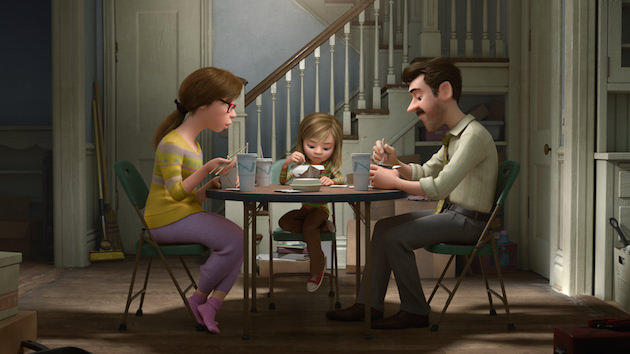
Researching the Mind
Part of Pixar’s narrative process is deep research, like going to Paris to photograph restaurants, skies, and sewers so they could credibly recreate the city of lights, as well as exhaustive research on why certain foods look good on film, for Ratatouille. For Inside Out, Docter and his team tasked themselves with understanding how motions evolve during adolescence.
They worked with scientists, neurologists, and psychologists, including Dr. Dacher Keltner, a professor of psychology at the University of California, Berkeley. It was through Keltner that the filmmakers pinpointed the emotions they wanted to feature. There is no consensus on how many emotions people have—the numbers range from four to 27. Ultimately they landed on five emotions that make nearly all of the lists.
For a pre-teen like Riley, dealing with a traumatic event like moving to a weird, unsettling new place, Joy and Sadness were selected as the emotions that go missing based on the reality of the adolescent mind. Adolescence involves a series of losses; friends, childhood, the unquenchable delight of being little and unconcerned with larger themes or worries. Being unable to feel joy, and unable to empathize with others, is the typical response of a sullen teen.
Creating the Look of the Emotions
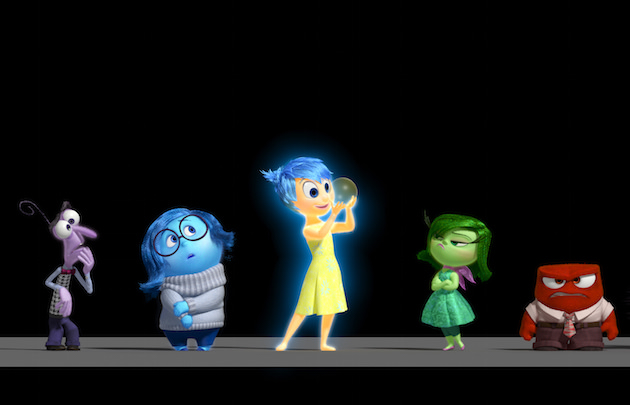
After the filmmakers settled on the five emotions (they had toyed with including Pride and, this would have been something, Schadenfreude, who delights in the pain of others), they needed to then figure out what they looked like.
“The look and design of the Emotions had to remind people that they are personifications of feelings,” says Docter. “They’re not little people. They’re Emotions. They’re made of energy—they’re made up of thousands of particles, which kind of looks like energy.”
But what to make an emotion actually look like? Character supervisor Sajan Skaria said that it was extremely difficult at the beginning. “Peter Docter said, ‘Make something my mom has never seen before.’ That’s it. That’s all we had to go on in the beginning.’”
Joy – Amy Poehler
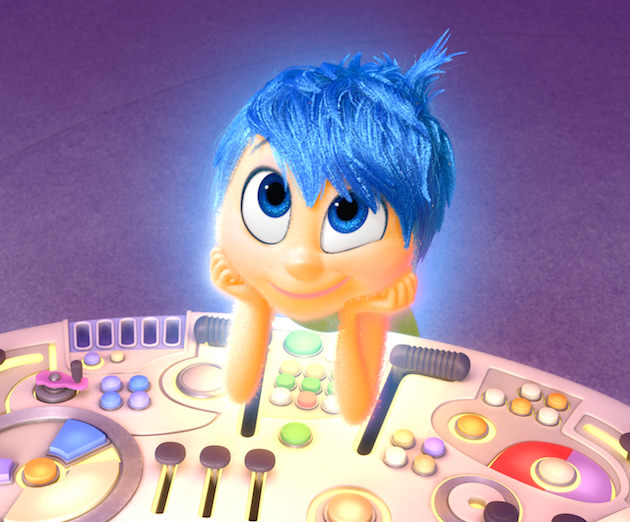
When Amy Poehler was cast as Joy, it helped the animation team hone in on the character. Supervising animator Shawn Krause said that Docter wanted Joy to “feel grounded, athletic—a bit of a tomboy” rather than saccharine, and Poehler’s acting choices helped inform the animator’s performance.
“The way that the chalk spattered on Ralph’s pastels, it reminded me of bubbles,” said character art director Albert Lozano, who was inspired by production designer Ralph Eggleston’s early efforts. “Joy is effervescent. Opening a champagne bottle in celebration felt like Joy to me. I do a lot of collage work, so I took the image of a sparkler, added a face, legs and arms, and that felt like Joy to me, too. I knew she had to emit joy.”
Joy’s eyes have at least twice as many controls as any Pixar character before her. They also serve as a light source, casting a yellow-blue glow around her. A whole system needed to be built to achieve the look filmmakers wanted.
Fear – Bill Hader
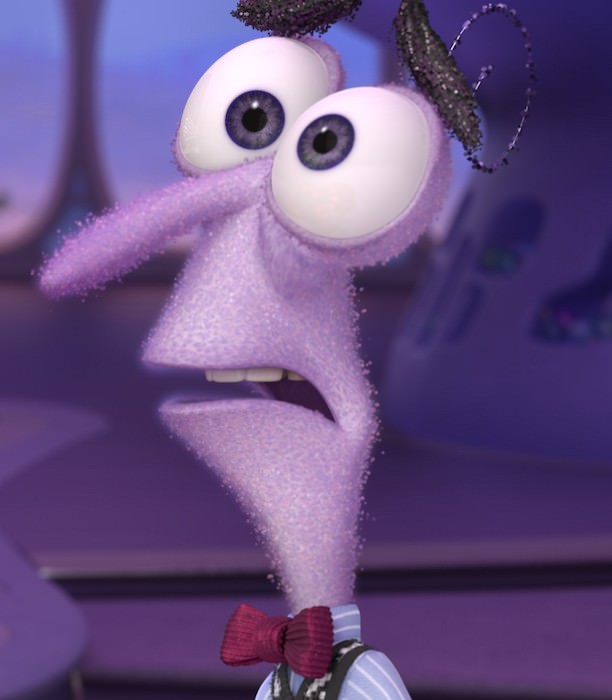
Fear’s role is to keep Riley safe. He looks out for pitfalls and potential dangers everywhere, all the time. The filmmakers had a much easier time creating him, from the screenwriting process to his look. “He was one of the easiest characters to write because everybody is driven by Fear at some point in the day,” screenwriter Josh Cooley says. “We had no trouble imagining how Fear might react to a given situation: He overreacts.”
“Early on, I just asked, ‘What if he’s just like a line and two eyes?’ character artist Chris Sasaki says. “It was as extreme as we could go and it snowballed from there.”
Note that single curlicue hair atop Fear's head; that strand can hit a million different poses to match whatever reaction or attitude he's having. The filmmakers treat it like a dog's tail: if he's sad, it droops, if he's in pain, it shoots up like a lightning bolt.
“He’s like one frazzled, frenetic, kinked-up nerve,” says Docter.
Anger – Lewis Black
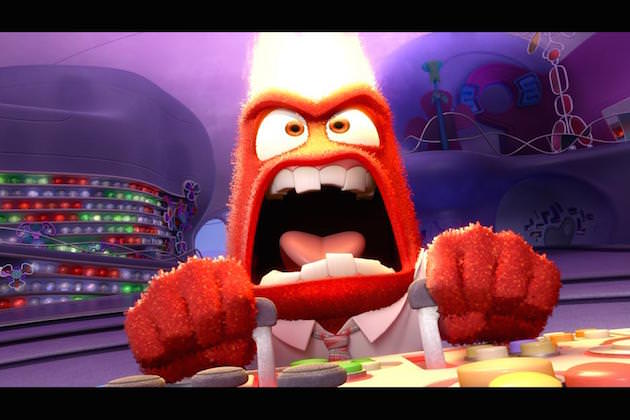
Anger’s job is to make sure things are fair for Riley. When he perceives that she’s been treated unjustly, he can get so angry he literally explodes. In early pitches, Black was actually the template voice the filmmakers used to suggest how they could bring Anger to life, and he was used as an example for the casting department. Docter ended up getting his man.
“Anger worked right out of the gate,” says supervising animator Victor Navone. “Once we had that rectangular shape and those angry brows and eyes, we just knew who he was. He has stubby arms and stubby legs and he can’t really turn his head because he doesn’t really have a neck. So we give him constant energy by having him shake and grumble. He does a lot of stomping around—very Lewis Black. And the fact that they cast Lewis Black really took it to the next level.”
After a lot of testing, the filmmakers realized that the realistic-looking fire they were using coming off of Anger’s head wasn’t working. Because these characters are all so stylized, and because they’re made of particles, they blended in Anger’s red hue with the color of the flames, skewing the usual look of fire to mesh perfectly with Headquarters colorful design, perfecting Anger’s incandescent fury.
Disgust – Mindy Kaling
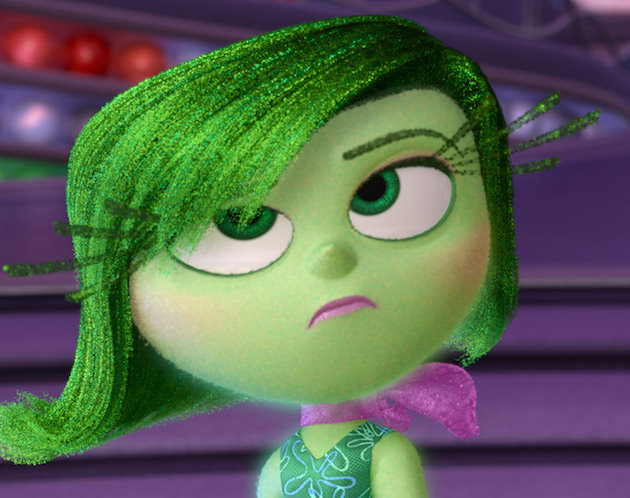
Disgust is opinionated, honest to a fault, and a careful observer of all the physical and social interactions Riley has with the world. Disgust is on constant guard to make sure Riley’s not tainted with people’s toxic behavior or fashion advice, is on the look out for gross food, and anything else that might lower Riley’s standards.
Disgust is not only shaped a little like broccoli, she’s also green. Docter turned to his emotion experts to hone Disgust’s personality, and learned that she emanates from bitterness. When you feed bitter food to babies, they make a face and stick their tongues out to spit out the food," Docter says. "That is the root of Disgust.”
Sandess – Phyllis Smith
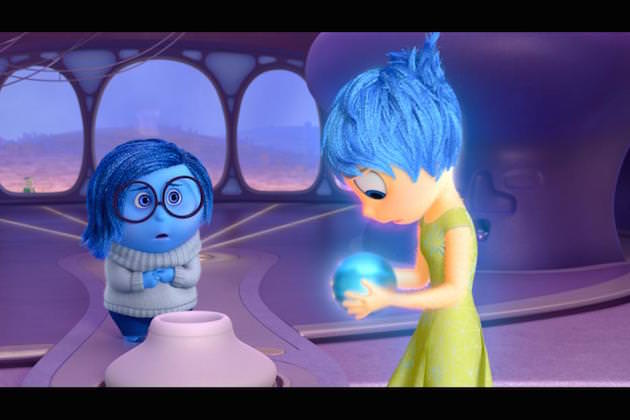
None of the other emotions really understand what Sadness is there for, and that includes Sadness herself. She questions her role, and what good she can do Riley, and worries she might actually be bad for her.
Obviously, Sadness would have to be blue. She’s also shaped like an upside-down teardrop. As Joy and Sadness go deeper and deeper into Riley's mind, Joy starts to see that Sadness has a function in Riley's world, and that as an emotion, it's just as valid as any other. Not your typical message in an animated film, and just one reason why Pixar's made something quite unique, both for themselves and the animated film world at large.
Featured image: INSIDE OUT – Anger, Fear, Joy, Sadness and Disgust look out upon Riley's Islands of Personality. ©2015 Disney•Pixar. All Rights Reserved.



